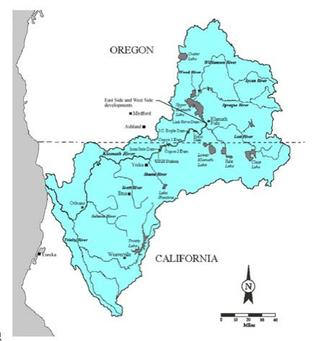|
Dam reports available to public
Removal of the Klamath dams would affect
regions in both Siskiyou County and southeastern Oregon.
By Courtesy of the Federal Energy Regulatory Committee
by David Smith,
Siskiyou Daily News, February 2, 2009
 Siskiyou
County, Calif. - A slew of reports concerning the potential
removal of four dams along the Klamath River have been released
for public viewing by American Rivers, including studies on
economic impacts, engineering and technical aspects of dam
removal, effects on aquatic life, a 2007 Federal Energy Regulatory
Committee (FERC) Final Environmental Impact Statement, effects of
sediment transport, water quality and others. One report,
concerning the presence of cyanotoxins in the water downstream
from the Copco 1 and Iron Gate reservoirs, states, “Some of the
highest levels of microcystin ever recorded in the world were
measured from Copco Cove in Copco reservoir.” The report is aimed
at verifying the Klamath’s designation as an impaired river by the
Clean Water Act standards. Siskiyou
County, Calif. - A slew of reports concerning the potential
removal of four dams along the Klamath River have been released
for public viewing by American Rivers, including studies on
economic impacts, engineering and technical aspects of dam
removal, effects on aquatic life, a 2007 Federal Energy Regulatory
Committee (FERC) Final Environmental Impact Statement, effects of
sediment transport, water quality and others. One report,
concerning the presence of cyanotoxins in the water downstream
from the Copco 1 and Iron Gate reservoirs, states, “Some of the
highest levels of microcystin ever recorded in the world were
measured from Copco Cove in Copco reservoir.” The report is aimed
at verifying the Klamath’s designation as an impaired river by the
Clean Water Act standards.
The report, compiled by the State Water Board, details a series of
tests of Klamath system mussels, perch and salmon for cyanotoxins,
which are recognized as dangerous to humans and some animals.
Using a variety of testing locations and samples, the water board
researchers concluded that variations exist along the river
system, namely, microcystin in yellow perch is higher in Copco
reservoir than Iron Gate, and the concentrations in yellow perch
and mussels is significantly higher in the summer than any other
time of the year.
The issue of cyanotoxins and blue-green algae in the Klamath has
been addressed in the past, and studies suggest that PacifiCorp,
if the dams are to be relicensed, will have to add measures to the
dams which will reduce or eliminate the presence of the algae in
order to have them relicensed.
The list of reports also contains a FERC estimate of the costs of
dam removal, using heavy construction materials data from 2007 and
using original construction reports to determine the amount of
material in each dam.
The cost estimates do not include the salvage value of materials
that could offset the cost of removal and assume that sediment
release will be done in a manner that does not require any
additional funding. The report states, “If contaminated sediment
is found, and is not suitable for downstream transport, the costs
of dam removal would be substantially higher.”
The estimates are as follows: • Decommissioning and removal of JC
Boyle facilities-$18,911,000; • Removal of contaminated sediment,
if needed-2 to 7 million dollars; • Decommissioning and removal of
Copco 1 Dam-$20,368,000; • Removal of contaminated sediment, if
needed-955 million dollars to 2.9 billion dollars; and •
Decommission and removal of Copco 2 dam-$3,731,000.
The report concludes that there is unlikely enough sediment behind
the dam to cause a problem; and Decommissioning and removal of
Iron Gate dam-$36,853,000. Removal of contaminated sediment, if
needed-485 million dollars to 1.5 billion dollars.
More reports will be detailed in future editions of the Siskiyou
Daily News.
|

